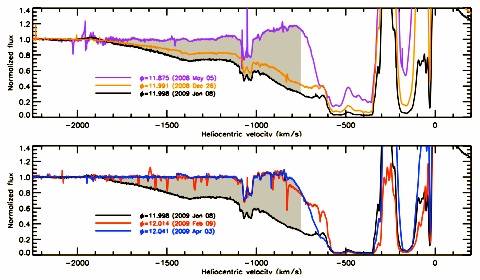Detection of high-velocity material from the wind-wind collision zone of Eta Carinae

We report near-infrared spectroscopic observations of the Eta Carinae massive binary system during 2008-2009 using the CRIRES spectrograph mounted on the 8 m UT 1 Very Large Telescope (VLT Antu). We detect a strong, broad absorption wing in He i λ10833 extending up to -1900 km s-1 across the 2009.0 spectroscopic event. Analysis of archival Hubble Space Telescope/Space Telescope Imaging Spectrograph ultraviolet and optical data identifies a similar high-velocity absorption (up to -2100 km s-1) in the ultraviolet resonance lines of Si iv λλ1394, 1403 across the 2003.5 event. Ultraviolet resonance lines from low-ionization species, such as Si ii λλ1527, 1533 and C ii λλ1334, 1335, show absorption only up to -1200 km s-1, indicating that the absorption with velocities -1200 to -2100 km s-1 originates in a region markedly more rapidly moving and more ionized than the nominal wind of the primary star. Seeing-limited observations obtained at the 1.6 m OPD/LNA telescope during the last four spectroscopic cycles of Eta Carinae (1989-2009) also show high-velocity absorption in He i λ10833 during periastron. Based on the large OPD/LNA dataset, we determine that material with velocities more negative than -900 km s-1 is present in the phase range 0.976 ≤ ϕ ≤ 1.023 of the spectroscopic cycle, but absent in spectra taken at ϕ ≤ 0.94 and ϕ ≥ 1.049. Therefore, we constrain the duration of the high-velocity absorption to be 95 to 206 days (or 0.047 to 0.102 in phase). We propose that the high-velocity absorption component originates in shocked gas in the wind-wind collision zone, at distances of 15 to 45 AU in the line-of-sight to the primary star. With the aid of three-dimensional hydrodynamical simulations of the wind-wind collision zone, we find that the dense high-velocity gas is along the line-of-sight to the primary star only if the binary system is oriented in the sky such that the companion is behind the primary star during periastron, corresponding to a longitude of periastron of ω ~ 240°-270°. We study a possible tilt of the orbital plane relative to the Homunculus equatorial plane and conclude that our data are broadly consistent with orbital inclinations in the range i = 40°-60°.
Groh, J. H., Nielsen, K. E., Damineli, A., et al. 2010, A&A, 517, 9

